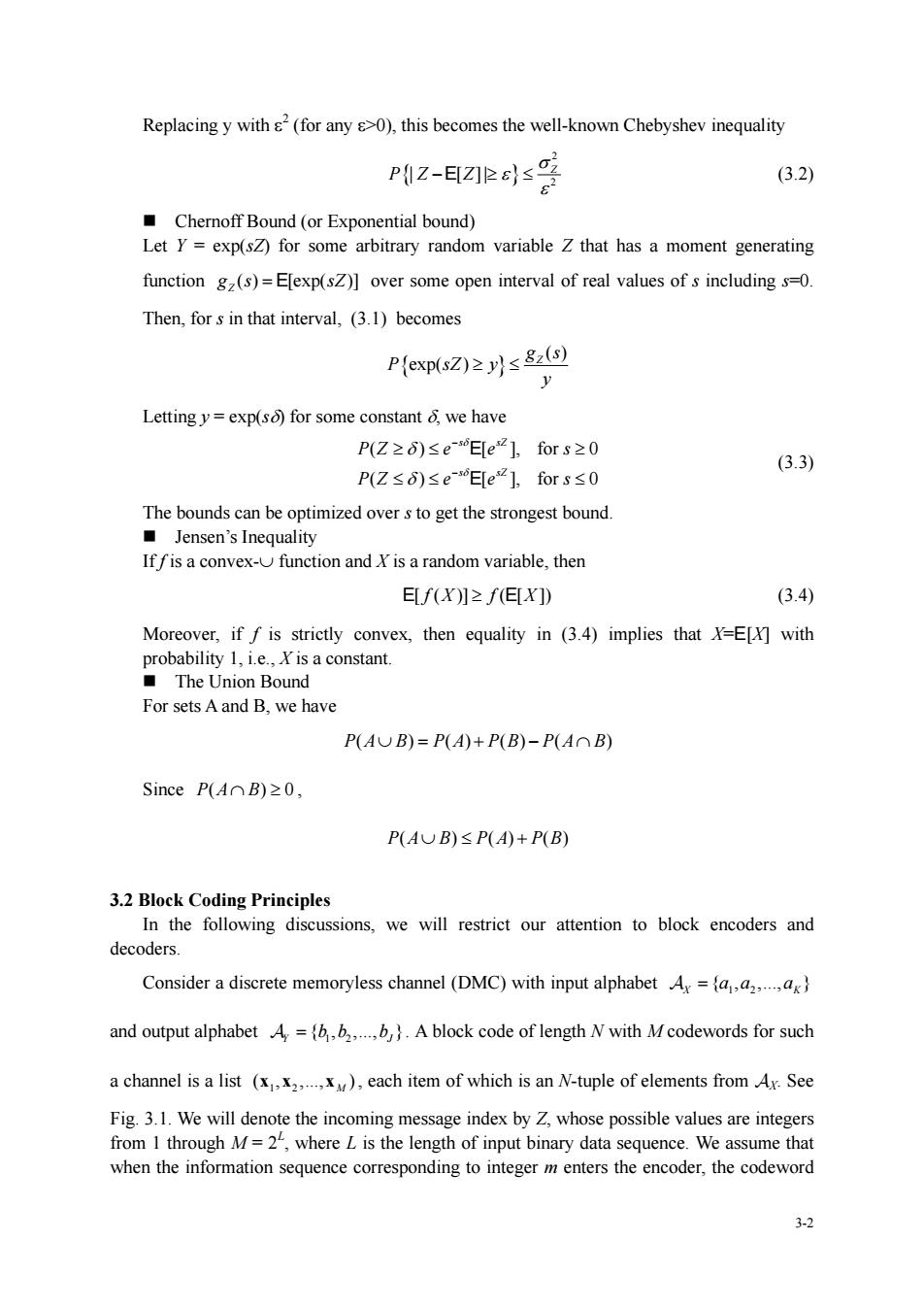正在加载图片...

Replacing y with(for any )this becomes the well-known Chebyshev inequality P(lZ-EZI)s (3.2) Chernoff Bound(or Exponential bound) Let Y=exp(sZ)for some arbitrary random variable Z that has a moment generating function gz(s)=E[exp(sZ)]over some open interval of real values ofs including s=0. Then,fors in that interval,(3.1)becomes P(exp(sz)() Lettingy=exp(s)for some constant we have P(Z≥6)≤eEe21,fors≥0 (3.3) P(Z≤6)≤ewEe2l,fors≤0 The bounds can be optimized overs to get the strongest bound. Jensen's Inequality If fis a convex-function and is a random variable,then ELf(XI≥(E[X]) (3.4) Moreover,iff is strictly convex,then equality in (3.4)implies that with probability 1,i.e.is a constant. The Union n Bound For sets Aand B,we have P(AUB)=P(A)+P(B)-P(AB) Since P(AnB)≥0, P(AUB)≤P(A)+P(B) 3.2 Block Coding Principles In the following discussions,we will restrict our attention to block encoders and decoders Consider a discrete memoryless channel (DMC)with input alphabet A= and output alphabet A.=(bbb.A block code of length N with Mcodewords for such a channel is a list ().each item of which is an N-tuple of elements from Ax.See Fig.3.1.We will denote the incoming message index by Z.whose possible values are integers from I through M=2,where L is the length of input binary data sequence.We assume that when the information sequence corresponding to integer m enters the encoder,the codeword 3-23-2 Replacing y with ε 2 (for any ε>0), this becomes the well-known Chebyshev inequality { } 2 2 | [ ]| Z PZ Z σ ε ε − ≥≤ E (3.2) Chernoff Bound (or Exponential bound) Let Y = exp(sZ) for some arbitrary random variable Z that has a moment generating function ( ) [exp( )] Z g s sZ = E over some open interval of real values of s including s=0. Then, for s in that interval, (3.1) becomes { } ( ) exp( ) Z g s P sZ y y ≥ ≤ Letting y = exp(sδ) for some constant δ, we have ( ) [ ], for 0 ( ) [ ], for 0 s sZ s sZ PZ e e s PZ e e s δ δ δ δ − − ≥≤ ≥ ≤ ≤ ≤ E E (3.3) The bounds can be optimized over s to get the strongest bound. Jensen’s Inequality If f is a convex-∪ function and X is a random variable, then E E [ ( )] ( [ ]) f X fX ≥ (3.4) Moreover, if f is strictly convex, then equality in (3.4) implies that X=E[X] with probability 1, i.e., X is a constant. The Union Bound For sets A and B, we have PA B PA PB PA B ( ) () () ( ) ∪= + − ∩ Since ( ) 0 PA B ∩ ≥ , PA B PA PB ( ) () () ∪≤ + 3.2 Block Coding Principles In the following discussions, we will restrict our attention to block encoders and decoders. Consider a discrete memoryless channel (DMC) with input alphabet 1 2 { , ,., } X K A = aa a and output alphabet 1 2 { , ,., } Y J A = bb b . A block code of length N with M codewords for such a channel is a list 1 2 ( , ,., ) M xx x , each item of which is an N-tuple of elements from AX. See Fig. 3.1. We will denote the incoming message index by Z, whose possible values are integers from 1 through M = 2L , where L is the length of input binary data sequence. We assume that when the information sequence corresponding to integer m enters the encoder, the codeword